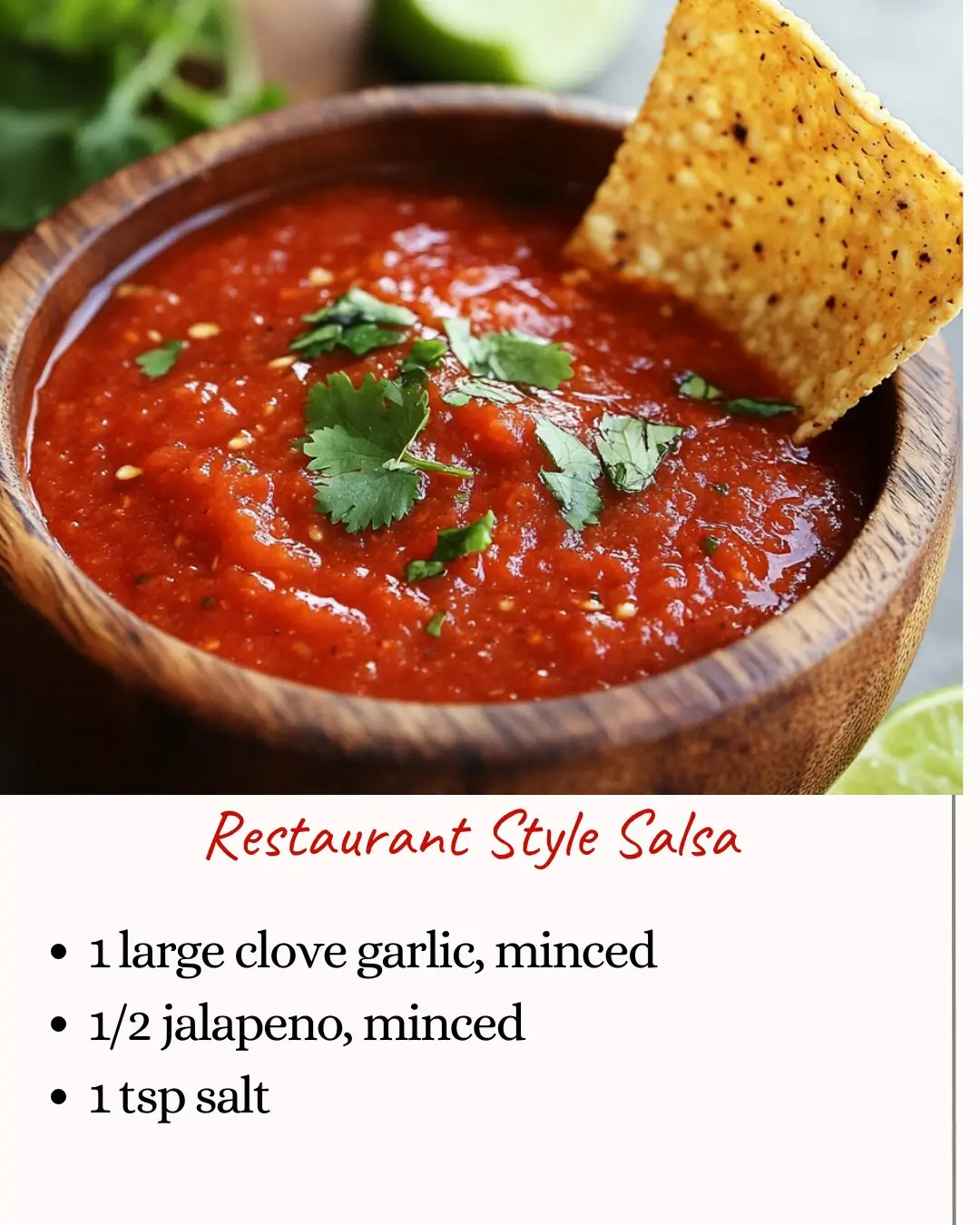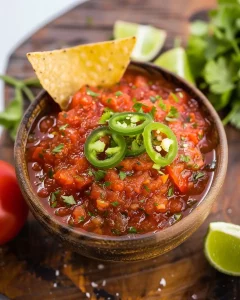Introduction to Restaurant Style Salsa
Restaurant-style salsa is a staple in Mexican cuisine, known for its fresh and vibrant flavors that pair perfectly with tortilla chips or as a topping for various dishes. This salsa is characterized by its smooth yet slightly chunky texture, achieved through blending ripe tomatoes, onions, and cilantro into a cohesive mixture. The combination of these ingredients creates a balance of sweetness, acidity, and a touch of heat, making it a versatile addition to many meals. Unlike store-bought versions, homemade restaurant-style salsa offers a burst of freshness that enhances the overall dining experience. Whether enjoyed as a dip or a condiment, this salsa is an easy and flavorful recipe that brings a taste of authentic Mexican cuisine right to your kitchen.
Print
Restaurant Style Salsa
- Total Time: 10 minutes
- Yield: 6 servings 1x
- Diet: Gluten Free
Description
A classic restaurant-style salsa made with fresh tomatoes, onions, cilantro, and a touch of spice. Perfect for pairing with tortilla chips or adding a burst of flavor to your favorite dishes.
Ingredients
1 (28 oz) can diced tomatoes, drained (or whole tomatoes)
2 (10 oz) cans diced tomatoes with green chilies, drained
1/3 cup onions, chopped
1/4 cup fresh cilantro, roughly chopped
1 large clove garlic, minced
1/2 jalapeno, minced
1 tsp salt
1/2 tsp cumin
1/2 lime, juiced
Instructions
Combine Ingredients:
In a large bowl, combine the diced tomatoes, diced tomatoes with green chilies, chopped onions, chopped cilantro, minced garlic, and minced jalapeno.
Season:
Add the salt, cumin, and lime juice to the mixture.
Blend:
For a smoother salsa, transfer the mixture to a blender or food processor and pulse until the desired consistency is reached. For a chunkier salsa, simply stir to combine.
Taste and Adjust:
Taste the salsa and adjust seasoning if needed (more salt, lime juice, etc.).
Chill (Optional):
For best flavor, refrigerate the salsa for at least 30 minutes before serving to allow the flavors to meld together.
Notes
For extra flavor, you can roast the tomatoes and peppers before blending. Adjust the level of spiciness by adding more or fewer jalapeños. The salsa tastes best when allowed to sit for a bit, giving the ingredients time to meld together.
- Prep Time: 10 minutes
- Category: Appetizer, Condiment
- Method: Blended
- Cuisine: Mexican
Nutrition
- Calories: 25
- Sugar: 3g
- Sodium: 150mg
- Fat: 0g
- Carbohydrates: 5g
- Fiber: 2g
- Protein: 1g
Keywords: Mexican salsa recipe, homemade salsa, authentic restaurant salsa
FAQs
1. Can I make this salsa spicier?
Yes, adding more jalapeños or using spicier peppers like serranos can increase the heat. You can also leave in the seeds for an extra kick.
2. How long does the salsa stay fresh?
When stored in an airtight container in the refrigerator, this salsa stays fresh for up to one week.
3. Can I use canned tomatoes instead of fresh?
Yes, canned tomatoes work well, especially fire-roasted varieties, which add depth to the flavor.
4. What dishes can I serve with this salsa?
This salsa is perfect for dipping with tortilla chips, topping tacos, burritos, and enchiladas, or as a fresh addition to grilled meats.
5. Can I freeze this salsa?
While it’s best enjoyed fresh, you can freeze salsa, though the texture might change slightly upon thawing. It’s ideal for using in cooked dishes later.
Key Ingredients for Authentic Flavor
The quality and freshness of the ingredients are crucial for achieving the authentic taste of restaurant-style salsa, as each component plays a distinct role in the overall flavor profile. Ripe tomatoes serve as the foundation, providing the natural sweetness and body that define the salsa. Onions, usually white or yellow, add sharpness and depth, while fresh cilantro brings a bright herbal note that ties the flavors together. Jalapeños or other chili peppers are essential for adding the desired level of heat, allowing you to customize the salsa’s spiciness according to your preference. Lime juice offers a burst of acidity that balances the richness of the tomatoes and enhances the brightness of the salsa, while salt and a touch of garlic powder round out the flavors, creating a harmonious blend that’s both refreshing and satisfying.
Steps to Prepare the Perfect Salsa
Preparing restaurant-style salsa at home is straightforward, requiring minimal time and effort while yielding impressive results. Begin by chopping the tomatoes, onions, and cilantro roughly, ensuring that they fit comfortably in your blender or food processor. Adding the jalapeños and garlic next allows these stronger flavors to blend more evenly with the other ingredients, ensuring a balanced taste. The key is to pulse the mixture gently until you achieve a texture that’s smooth but still retains some small chunks, giving the salsa that authentic, restaurant-quality consistency. Once blended, taste the salsa and adjust the seasoning with additional lime juice, salt, or cilantro to suit your personal preferences. Allowing the salsa to rest for at least 15 minutes before serving helps the flavors meld together, making the taste even more vibrant and cohesive.
Serving Suggestions and Pairings for Maximum Enjoyment
Restaurant-style salsa shines in its versatility, making it an excellent accompaniment for a wide variety of dishes and snacks beyond just tortilla chips. Serve it alongside grilled meats like chicken or steak to add a fresh, zesty contrast that cuts through the richness of the proteins. It also works beautifully as a topping for tacos, burritos, or enchiladas, providing a burst of flavor that complements the spices and ingredients commonly found in Mexican dishes. For a lighter option, use the salsa as a dressing for salads or as a garnish for eggs in dishes like huevos rancheros. The combination of flavors and textures makes this salsa a must-have for any gathering, from casual weeknight dinners to festive parties, where its bright, fresh taste never fails to impress.
Tips for Storing and Customizing Your Salsa
Storing leftover salsa properly ensures that its flavor and freshness are maintained for future use, while allowing it to develop even more depth as it sits. Transfer the salsa to an airtight container and refrigerate it, where it will stay fresh for up to a week, making it convenient for meal prepping or quick snacking throughout the week.
For those who prefer a spicier kick, adding additional jalapeños or experimenting with spicier varieties like serrano or habanero peppers can elevate the heat level without compromising the overall balance. On the other hand, if you prefer a milder salsa, removing the seeds and membranes from the peppers before blending will significantly reduce the heat while preserving the essential flavors. You can also experiment by incorporating additional ingredients like roasted tomatoes, tomatillos, or even a touch of sugar for a sweeter twist, allowing you to tailor the salsa to your specific tastes and preferences.





